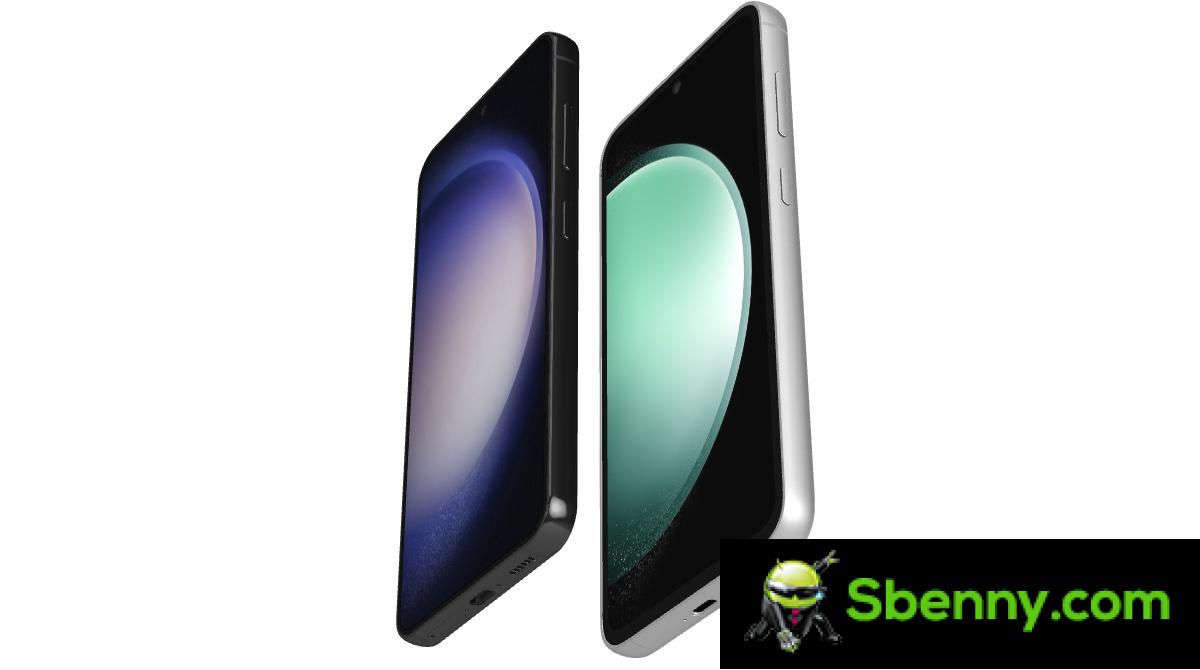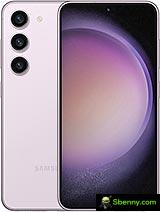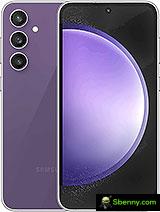Samsung Galaxy S23 and Galaxy S23 FE are two interesting smartphones, part of the current flagship generation. It is natural to wonder about their differences, their performance and, above all, which one to choose. If so, then you are in the right place.
The Galaxy S23 FE is more like a Galaxy S22 FE that arrived late to the party as it features chips from the previous generation and shares much of the same hardware. Although the extra weight and thicker bezels betray its less-than-premium nature.
Summary:
Let’s start by comparing the full spec sheets here.
Size comparison
The Galaxy S23 FE is noticeably larger and heavier than the compact Galaxy S23. Sure, it has a larger display, but we also found it to have thicker bezels and body, which further contributes to this build being more mid-range than flagship.
Aside from size and weight, the phones look similar as they feature an identical design with flat Gorilla Glass panels, an aluminum frame, and three camera rings. The Galaxy S23 uses Gorilla Glass Victus 2, while the S23 FE relies on older Gorilla Glass 5 sheets.
Both phones have an IP68 rating for dust and water resistance and are designed to withstand a depth of 1.5m.
Aesthetically, both flagships are incredibly beautiful, although the Galaxy S23’s lighter and more compact body gives it a certain advantage over the FE.

View the comparison
Both Galaxies use Dynamic AMOLED 2X screens with identical resolutions and maximum refresh rates. The Galaxy S23 FE has a slightly larger screen and therefore a slightly lower pixel density.
The Galaxy S23 has the brighter display although it’s not a major difference – 1198 nits vs. 985 nits in automatic mode e 476 nits vs. 451 nits with manual control.
Both screens offer accurate color calibration.
The Galaxy S23 has very granular control over the refresh rate: the screen dynamically changes between 120Hz, 90Hz, 60Hz, 30Hz and 24Hz on the move, depending on the content. Meanwhile, the Galaxy S23 FE only uses fixed 120Hz and 60Hz modes.
Finally, the two Galaxies support HDR10+ streaming.
Battery life
The Galaxy S23 is powered by a 3,900 mAh battery, while the Galaxy S23 FE has a larger 4,500 mAh cell.
The Galaxy S23 FE performed worse in all of our active battery tests, except for voice calls. It scored at least 1 hour less in web, video streaming, and gaming scenarios, resulting in a lower-than-average active usage score of 9:45 hours. The newer chipset inside the S23 is much more power efficient.
Charging speed
The Galaxy S23 and S23 FE are officially rated for 25W wired fast charging. Wireless charging goes up to 15W, and there’s also support for reverse wireless charging.
Despite the differences in battery capacity, the Galaxies charge just as quickly, just like Apple’s iPhones.
Test the speakers
The Galaxy S23 and Galaxy S23 FE both feature hybrid stereo speaker setups with a dedicated bottom-firing speaker for one channel and an amplified earpiece for the other.
The Galaxy S23 FE has the more powerful speaker system: it got a very good rating in our loudness test, while the Galaxy S23 got a good rating. However, both offer pleasantly rich and deep audio quality.
Performance
The Samsung Galaxy S23 is powered by the Snapdragon 8 Gen 2 for Galaxy – it’s a once-Samsung-exclusive version with an overclocked CPU and GPU compared to the mainstream SD8G2.
The Galaxy S23 FE brings back chipset fragmentation, and different markets get different hardware platforms. The US version features the Snapdragon 8 Gen 1 SoC (our review unit), while the global model elsewhere is based on the Exynos 2200 chip. Both hardware platforms are a generation older than that of the regular Galaxy S23 series-derived Galaxy S22.
As expected, albeit relevant, the Galaxy S23 FE is inferior to the Galaxy S23 not only in terms of energy efficiency, but also in terms of performance.

SAMSUNG
Galaxy S23
AnTuTu 10
1,464,257
Geekbench 6
1,550 single cores
Geekbench 6
5,327 multicores
In addition to performance, the Galaxy S23 FE also offers internal GPU stability: 60% versus 46%. The S23 FE can stay at peak performance for about 5 minutes, just like the Galaxy S23, and then it’s all downhill from there. And while this doesn’t exactly represent real-life gaming, you can expect performance drops from time to time in demanding games.
Having a faster GPU and better GPU stability, the Galaxy S23 seems to be, without a doubt, the best in this case.
Camera comparison
Both the Galaxy S23 and Galaxy S23 FE feature similar three-camera setups on the back: wide-angle, UW, 3x tele. Front imagers, while different in resolution, are also similar in terms of lenses and quality.
Both Galaxies have the same 50MP primary OIS.
The 3x zoom camera uses similar OIS lenses, but the Galaxy S23 has a 10MP sensor, while the S23 FE has an 8MP sensor.
The ultrawide cameras on both phones feature 12MP sensors with similar ultrawide lenses.
Finally, the Galaxy S23 has a 12 MP selfie camera with AF, while the FE model has a 10 MP one with AF.
Long story short, the main and ultrawide cameras appear to be pretty similar on both Galaxy S23 models, while the FE model has lower resolution zoom and selfie cameras.
The main cameras on both phones deliver equally great photos with slightly saturated colors. There’s plenty of resolved detail in all photos, with low noise, high contrast, and wide dynamic range.
The same goes for ultrawide cameras: there’s a lot of resolved detail, noise is low, and the field of view is impressively wide. There is minimal corner softness and images do not exhibit a fish-eye look.
The enlarged photos are also almost identical, but there is a small difference in sharpness between the enlarged photos in favor of the Galaxy S23. That’s because both phones bump up their power to 12MP, but the Galaxy S23 goes from 10MP to 12MP, while the S23 FE goes from 8MP to 12MP.
Finally, the Galaxy S23’s 12MP selfie offers a little more detail thanks to the higher-resolution sensor than the S23 FE’s 10MP mugshot. Again, it’s a small difference, but it’s there.




Galaxy S23: 1x • 3x • 0.6x • selfie




Galaxy S23 FE: 1x • 3x • 0.6x • selfie
And here’s another comparison:



Galaxy S23: 1x • 3x • 0.6x



Galaxy S23 FE: 1x • 3x • 0.6x
Samsung’s camera app supports automatic night mode in low light: it appears as a small moon icon, and if you tap it, you’ll disable it. It usually takes 1 second less than normal night mode, but we found that automatic night mode (where it triggered) and normal night mode output are identical on all cameras.
Both the Galaxy S23 and S23 FE offer identical photos from all three cameras. There are some incredibly small differences in noise levels and overall clarity, but for all intents and purposes they are virtually the same.



Galaxy S23: 1x • 3x • 0.6x



Galaxy S23 FE: 1x • 3x • 0.6x
Finally, let’s talk about video capture. The Galaxy S23 can run up to 8K30 video and capture 4K60, while the Galaxy S23 FE maxes out at 8K24, although it still supports 4K60.
Daytime videos offer equally high quality from both smartphones.





Galaxy S23: 8K main • 4K main • 4K 3x tele • 4K UW • 4K selfie





Galaxy S23 FE: 8K main • 4K main • 4K 3x tele • 4K UW • 4K selfie
The Galaxy S23 has a small advantage over the S23 FE when it comes to nighttime noise reduction for prime and ultrawide video.



Galaxy S23: 4K main • 4K tele 3x • 4K UW • 4K selfie



Galaxy S23 FE: main 4K • tele 3x 4K • UW 4K • selfie 4K
Here’s a glimpse of how the Galaxy S23’s main camera compares in image quality to that of the Galaxy S23 FE in our photo comparison tool.
And here’s how the Galaxy S23’s main camera compares in terms of video quality to that of the Galaxy S23 FE in our video comparison tool.
Verdict
As far as we know, the Samsung Galaxy S23 FE is officially only available in the US, Canada, Australia, Turkey, and several Asia Pacific countries at the time of writing. It has been subject to both price increases and decreases since its launch. It will supposedly launch in Europe in December or January for around £599 and €650.
And with these prices in mind, the Galaxy S23 FE doesn’t exactly look like a more affordable alternative to the Galaxy S23, but to the Galaxy S22 or S22+. Not that it really matters, but it’s just that the Galaxy S23 FE is neither a Fan Edition, nor a real S23. It’s more like an S22 FE that comes very late to the party, as everyone expected it around the time the S23 series came out.
Long story short: you either get the Galaxy S23 for its more powerful hardware and slightly better cameras, or you get the Galaxy S23 FE for its larger screen and slightly louder speakers. And that’s only if you can’t find the Galaxy S22+ for the same price.

- The most compact body.
- The most robust structure: Gorilla Glass Victus 2.
- Faster Snapdragon 8 Gen 2 chipset.
- High resolution zoom and selfie cameras.
- Better battery life.
Get the Galaxy S23 for:

- The biggest screen.
- Louder speakers.
- The cheapest price.







Start a new Thread